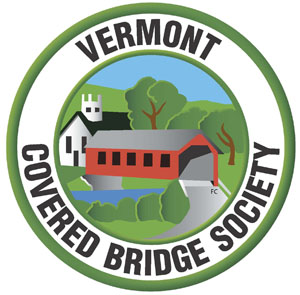
THE BRIDGER
The Vermont Covered Bridge Society Newsletter Fall 2017 Issue #70
- Events
- From the Editor
- Election Slate Filled
- We Are Pleased to Announce...
- Long Live the Vermont Covered Bridge Society
- Membership Committee
- Building a Better Lattice Truss
- Vermont 4th Ranking State for Ancient Covered Bridges
- Bridge-Watch
- From The Archives
- VCBS Lending Library
- For Sale
- VCBS Contacts
Events
Vermont Covered Bridge Society
Annual Fall Meeting
October 8, 2016,
10:00AMIlsley Library
75 Main Street
Middlebury, Vermont
Meeting Agenda
- 9:00 am
- Set-up time. There will be no business meeting.
- 10:00 am
- Meeting called to order. Robert McCullough will speak on historic site preservation and on the Scott Bridge experience.
- 11:00 am
- Social hour. Members are invited to bring and display their covered bridge memorabilia, covered bridge photos, covered bridge postcards, and whatever may be of interest to their fellow members. A slide projector and a digital projector and screen will be provided. Dining arrangements and bridge tours will be discussed. The sales table will be open, but the usual drawing will not be held. Snacks will be provided.
- 12:00 pm
- Meeting adjourned.
The meeting is open to all comers. There are no fees. For overnight accommodations, call the Middlebury Chamber of Commerce for a list of area lodging. The phone number is 1-802-388-7951.
Travel Directions:
The meeting will be held in the public room of the Ilsley Library. Go to the rear of the building and take the ramp behind the fence to the downstairs room.
Directions from the North on Route 7
Turn right at the church onto Route 30, go through downtown, enter the roundabout at 6 o'clock, exit it at about 9 o'clock (but do not enter the bridge), instead take the road to the right which leads to the parking lots. The upper parking lot immediately behind the library is accessible from the lower lot.
Directions from the South on Route 7
At the fifth traffic light, turn left onto Cross Street and proceed across the bridge. Turn right immediately into the parking lot before reaching the roundabout.
From the Editor
If you're wondering why this issue of The Bridger looks different, I have an answer for you. My name is Melanie Schropp, and I have volunteered to relieve Bill Caswell and serve as your newsletter editor. Although I live in Westerville, Ohio, I have a deep love for Vermont, including its culture and history; and covered bridges are the lasting legacy of that history. My husband and I have traveled to Vermont every year for nearly two decades. I have enjoyed visiting in the fall, as well as the spring and winter. I love learning about Vermont's history and visiting the places where that history happened. When I discovered that the Communications Committee was searching for someone to assume the responsibilities of newsletter editor, I eagerly responded. I look forward to meeting many of you at the annual fall meeting on October 21.
Election Slate Filled Incumbents Will Continue in Office
For lack of challengers, the incumbent officers will stand again for two-year terms, beginning January 1, 2018. The slate includes:
- William Carroll, President
- Joe Nelson, Vice President
- Neil Daniels, Treasurer
- Irene Barna, Secretary
William Carroll has stated that this will be the last time he will run for office. Neil Daniels is offering to relinquish his post as treasurer to a volunteer during his upcoming two-year term.
With the summer issue of The Bridger, we began the process of electing Society officers. The Vermont Covered Bridge Society membership was asked for candidates to run for the offices of president, vice president, secretary, and treasurer. Non-incumbent candidates were asked to introduce themselves to the membership by letter to tell us why they are seeking a leadership role. The letters were to be published in the fall issue of The Bridger together with a ballot. There were no letters. Fortunately, the incumbents have all agreed to continue serving. There will be no ballots. The Society bylaws governing elections read that if there are no challenging candidates for any of the four offices, election ballots will not be issued and the Board of Directors will confirm the slate.
Every member in good standing is entitled to run for office and to vote. This includes the adult members listed on a family membership and the contact person on a business or organization/municipality membership.
This is an open organization and all members are invited to participate, giving of their time and talent. If you don't wish to run for one of the four offices, you are urged to join a committee or to join the Board of Directors by chairing a standing committee or a bridgewatch area.
We Are Pleased to Announce...
We are pleased to announce that member Melanie Schropp of Westerville, Ohio, has volunteered to edit the society newsletter, The Bridger, relieving Bill Caswell. Bill has done an excellent job developing our newsletter into a first-rate advocate for the preservation of our covered bridges.
We are also pleased to announce that Dan Monger of New Haven, Vermont, has volunteered to assume the chairmanship of the Membership Committee. Additionally, Steve Miyamoto, our website and Facebook guru, has assumed the duties of Publicity Committee Chair. A volunteer - run organization like the Vermont Covered Bridge Society needs worker bees like Melanie, Dan, and Steve to fulfill its mission.
We are asking our membership to please give serious consideration to the Society's still outstanding needs:
- Wanted: A volunteer to assume the duties of the Events Committee Chair
- Wanted: A volunteer to assume the duties of Treasurer
- Wanted: Reporter/correspondents to bring local covered bridge news to The Bridger
- Wanted: A volunteer to take charge of the Covered Bridge Market Place. The market place brings us funds to support our Save-a-Bridge program.
- Wanted: Committee members for the Standing Committees, i.e. Bridge Watch, Communications, Events, Historical, Legislative Watch, Membership, and Publicity. The duties of each committee are described at http://www.vermontbridges.com/whatis.vcbs.htm#item5.
- Wanted: Bridge Watchers. If there is a covered bridge in your locale, sign up as a bridge watcher and keep your Society informed of events involving your bridge.
- Wanted: Vermont Covered Bridge clippings from your local newspaper. Please send them to Joe Nelson, jcnelson@together.net or VCBS, P.O. Box 267, Jericho, VT 05465. He will share them with the newsletter and the Historical Committee.
For more information or to sign up for any of these positions, please contact Joe Nelson, Communications Committee Chair, jcnelson@together.net or Bill Carroll, wcarroll@crocker.com
.Long Live the Vermont Covered Bridge Society
By Joe Nelson
After each of our society's elections, I remember with a cold chill Alma's letter about the Zumbrota Covered Bridge Society.* Our officers today are virtually the same folks who led the Society from its beginnings back in the year 2000. Including myself, I believe our average age among the four of us is somewhere in the high 70's and low 80's. We desperately need some of our younger members to carry on our commitment to our historic covered bridges.
We have adopted the Burlington Charter for the Preservation of Historic Covered Bridges, approved June 6, 2003, at the First National Best Practices Conference for Covered Bridges, Burlington, Vermont. We need committed members to step forward and carry out our promises. To read what we have sworn to, go to http://www.vermontbridges.com/whatis.vcbs.htm#item6.
The VCBS has a seat on the Vermont Agency of Transportation's Historic Covered Bridge Committee. With our presence there, we can track the agency's compliance with the Burlington Charter. Unfortunately, in Vermont, the towns own the covered bridges, and often VTrans must bend to their wishes. For example, the Longley Covered Bridge (WGN 45-06-08) in Montgomery was dismantled and its historic fabric taken by a maple sugar producer. The town refused a bypassing bridge to accommodate modern traffic and opted for a replica covered bridge that could handle the traffic. The VCBS had no voice in the matter, lacking taxpaying members resident in the town to speak on behalf of the bridge. As a result, the historic Longley Bridge is no more. Let us hope there are no more Longley Bridge situations, and let us hope for better responses from our membership to the society's needs while there is still time.
Membership
I hope you've all been enjoying the summer and perhaps had an opportunity to take in a covered bridge or two that you hadn't yet seen.
We are grateful for all of our members, and we hope you'll continue to be members for years to come. If you are not yet a member, please consider joining us by visiting www.vermontbridges.com. Membership dues are incredibly reasonable, and they support a cause that is important to all of us. All are welcome!
Growing our membership is vital, and we encourage you to help us do that. Spread the word about VCBS and why it's important to you and to our communities. Invite your family and friends to be a part. Mention us on social media and encourage people to check out our website and join our Facebook page. Perhaps you could even post a photo or two that you've taken of a Vermont covered bridge on the VCBS Facebook page. Let's get the word out about VCBS.
I would like to introduce Dan Monger as your new membership coordinator. I have enjoyed being in this role for the past couple of years, but life is getting busy and it's time to pass the torch to someone else. I am deeply passionate about covered bridges and the mission of VCBS, and I will remain involved in the years to come. Dan can be reached at teelmonger@gmavt.net. Welcome, Dan!
Wendy Payson
Happy Birthday and Anniversary to:
- September
- 4 Johnny Esau
- 5 Robert Salvi
- 9 Tom Walczak
- 10 Gordon & Priscilla O'Reilly
- 12 Dell Hoch
- 15 Henry Rowse
- 15 Lou & Mary Zabbia
- 17 Doris Taylor
- 21 Wilfred Thompson
- 25 Bonnie Shultz
- 27 Johnny & Joanne Esau
- 29 June Evans
- October
- 9 Erwin & Virginia Eckson
- 11 Trish Kane
- 20 Phil Pierce
- 21 John & Joanne Billie
- 22 Ellen Everitz
- 28 Joyce Soroka
- November
- 13 Bruce Wagner
- 18 Euclid Farnham
- 18 Bob and Mary Ann Waller
- 22 Marikka Guay
- 25 Richard & Gloria Davis
- 28 Joyce Soroka
Building a Better Lattice Truss
By Jan Lewandoski Stannard, Vermont
July 17, 2017: I recently visited three lattice truss covered bridges: Pont de la Frontiere (or Mud Creek) near Mansonville, Quebec (1896); the Schoolhouse Bridge near North Troy, Vermont (1910); and the Narrows Bridge at the Narrows on Fitch Bay, Quebec (1881).
Since a large part of my occupation for the last 30 years has been restoring failing or damaged wooden trusses, I usually meet covered bridges with serious, sometimes catastrophic problems, or ones that have been dramatically altered by the addition of piers or steel or glulam beams, circumventing the original structural system. I'm happy to say that these three bridges are in good to very good condition, dependent only upon their original structural design, and also represent two very different successful variations of the Town lattice system.
My initial interest in these bridges was sparked by a recent visit to Pont de la Frontiere, where I saw a bridge obviously neglected and bypassed, yet retaining lots of positive camber and not racked or bowed. I contacted Michael Grayson, an engineer in the Eastern Townships with lots of covered bridge experience and asked him, "Why is this bridge so good?" These bridges at Mansonville and North Troy, both about 90 feet in the clear, challenge many of our ideas about what makes a lattice truss work. Both have two bottom chords and only one top chord, a configuration that does show up occasionally elsewhere in New England.
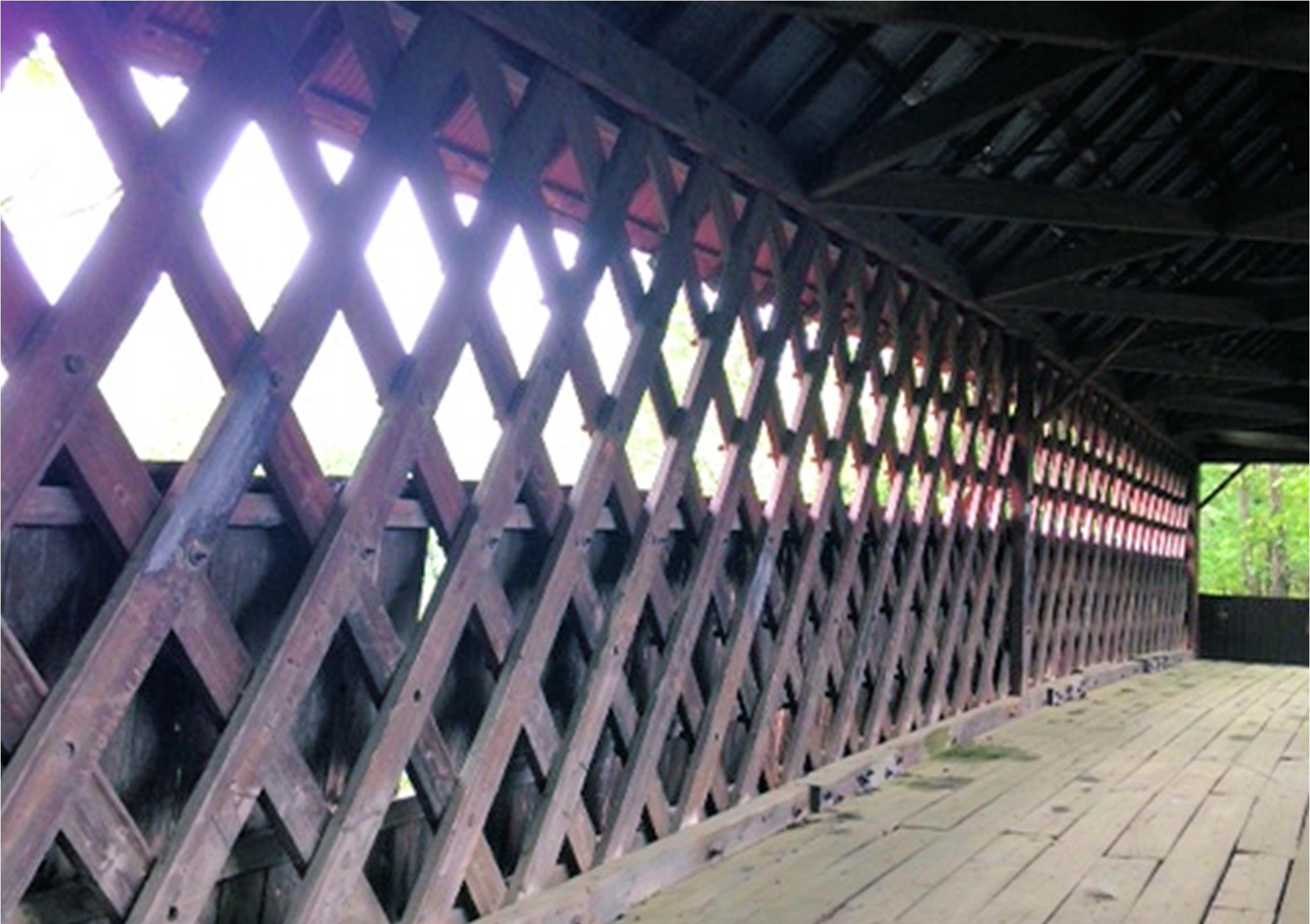
The lattices are small, 2x9 inch, but they are spaced more closely than the usual four feet (measured horizontally along the chord), and their angle of incline is slightly steeper than the typical 45 degrees. The close spacing and lack of a subsidiary upper chord results in six lattice crossings between the chords rather than the usual three or four.
The chord members are not 3x11 lamina with overlapping and breaking joints, but rather 5x11 and 6x11 timbers in a line with hardwood fishplates dapped and bolted into them at their junctions. There are no interior diagonal knee braces, except as part of the portal framing. Rather, there are external buttresses based upon extended floor beams at each end and at mid-span.
Another interesting and perhaps valuable feature on the de la Frontiere Bridge is a flared skirt, starting above the subsidiary bottom chord that, if maintained well, keeps the lower chords airier and further from moisture.
According to Richard Sanders Allen in his 1959 book Covered Bridges of the Northeast, "in Troy and Westfield are three odd buttressed bridges, with lattices joined at the intersections by a single pin - something of a rarity" (p. 60). I believe Schoolhouse is now the last of this type in Vermont. The Schoolhouse Bridge in North Troy has seen recent and quite faithful restoration work and is a busy crossing, rated at 24,000 lbs. De la Frontiere awaits restoration.
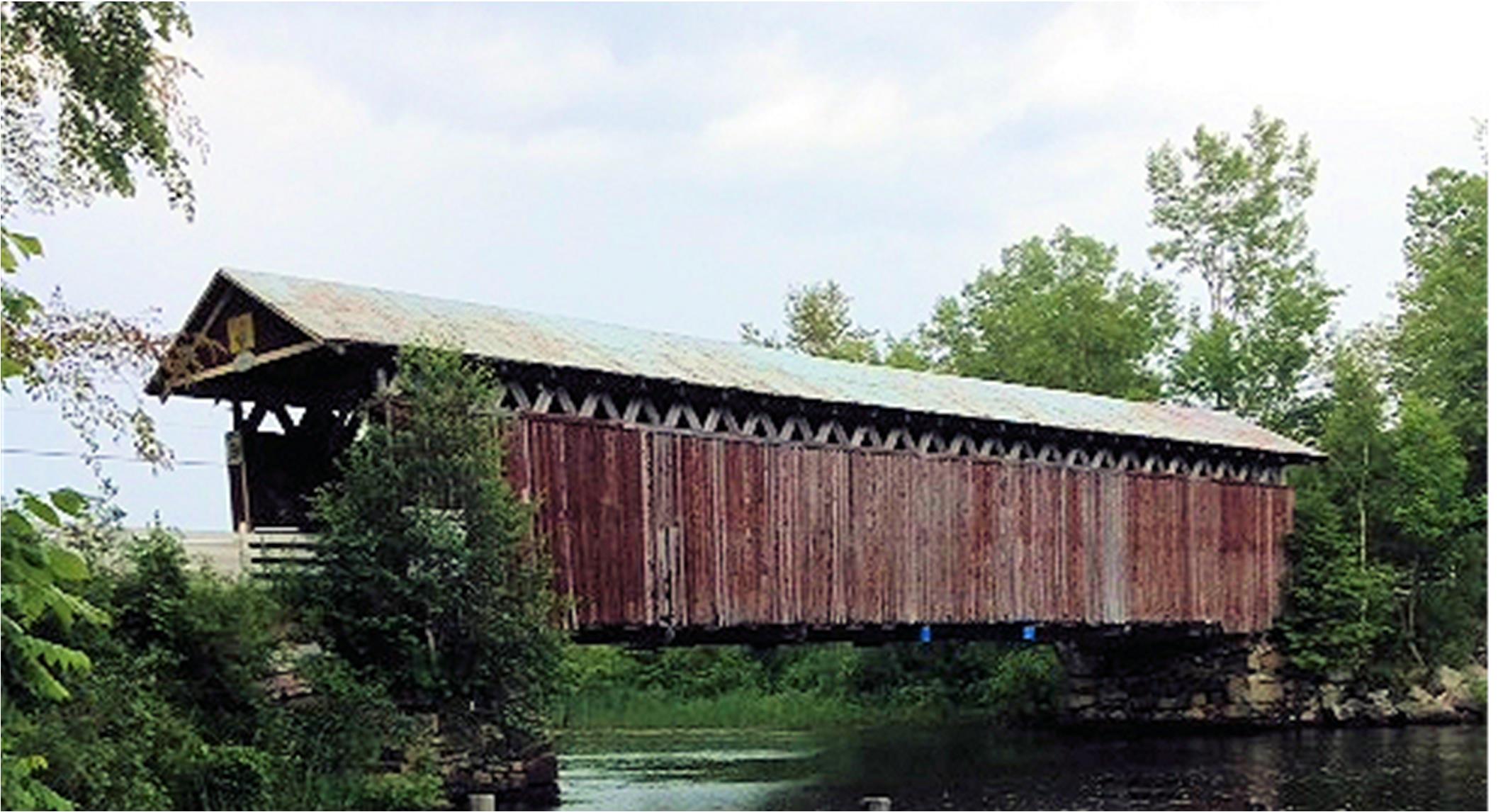
The Narrows Bridge at Fitch Bay, P.Q., is a Town lattice truss constructed by Charles MacPherson in 1881. It is currently bypassed by a modern highway bridge but remains open as a popular tourist destination. Its condition is very good and just looking at its construction inspires confidence. It's certainly a Town lattice, just improved in many details.
The lattices are 3x12 hemlock, with their angle steepened to around 60 degrees. This steepening of the lattice results in fewer intersections between the chords. There are two pins at each lattice intersection as well as chord intersections. The chords are composed of lamina of 4x12's rather than the usual 3-inch plank and are joined not only by the intersection pins (again, the usual practice) but by hardwood shear keys, dapped between the lamina every few feet with bolts, not through the smallish keys, but nearby to keep them in full bearing. There are two upper and two lower chords.
Bracing is restricted solely to the portals where there are currently 4x4 diagonals, but with improved connections over what is usual to lattice trusses. However, these recently replaced naturally curved knees, which, original themselves or not, were an even better form of wind bracing.
I think this example of yet another bridge with no wind bracing between the portals (some other lattice trusses dispense with it as well as all Howe Trusses), yet no problems of rack and bow, suggest that we don't understand something about the structural behavior of wood truss bridges. But that is a question for another day.
Vermont 4th Ranking State for Ancient Covered Bridges *
September 26, 1948: Covered bridges, familiar landmarks of serene country roads, are still an important factor in our country's transportation system. A recent study by the American Road Builders' Association (ARBA) reveals that those favorite spooning sites for grandma and grandpa have more than proved their worth both economically and through records of service.
Vermont's covered bridges are perhaps the most widely-known. And although a great many were lost in the disastrous floods of 1927 and 1945, the Green Mountain State ranks fourth in having the most still in service. Richard S. Allen of Round Lake, N.Y., leading statistician on covered bridges, places Ohio first with 592 covered bridges still in use. Pennsylvania ranks second with 336, Indiana third with 194, and Vermont, the smallest of the four, last with 170.
Favorite subjects of landscape painters and a delight to amateur and professional photographers, these antiques of the road have by no means passed their prime of usefulness, ARBA learned in its survey.
Contrary to popular belief, they did not originate in the United States. The first in this country was built in Pennsylvania in about 1771. From there, the strain spread to New England, where it flowered about 20 years later. Each of individual design, they are found on secondary roads from Maine to Oregon, and in other wooded sections of the world throughout the European and Asiatic continents. One of the oldest on record is located in Switzerland.
Although many of these highway veterans were not built according to modern engineering plans, they remain a testimony to the integrity and ingenuity of our country's first bridge builders.
Improvements in their construction have come about through the years, but the roofing of the bridge to protect the timbers has continued in practice. Styles of today's counterparts have also departed from those of their rustic pal forerunners. A far cry from the crude bridges that spanned New England's streams are those native to Oregon.
A thrifty New Englander would have difficulty accepting a covered bridge spotlessly painted white with a green roof and gothic-type windows.
Oil-impregnated wooden pegs, termed "treenails", that formerly held planks and studding together, have given way to the supremacy of iron nails and bolts. But, the load capacity of these hardy bridges has been found to be substantially above that anticipated by the original designer. Standard doorway dimensions were, categorically, as high and wide as a load of hay.
Many of them have fallen prey to floods, but it is well substantiated that those homespun structures ably withstand the ravages of spring freshets. Intact, a covered bridge will float down a swollen stream to be later salvaged and reset on its original abutments or relocated.
Not all of them were designed to accommodate vehicular traffic. A few covered foot bridges and railroad bridges are still in service. It is not uncommon, though, to see a pedestrian walk jutting out from one side of a covered bridge or railed off from the roadbed inside the main structure.
In the New England states alone, nearly 300 are still carrying a daily load of traffic. Actual figures are difficult to compile since many of these bridges are now privately owned. In other instances, townsfolk have taken these bridges into their hearts and preserved them by turning them into museums or storehouses. Thus they keep for posterity a bridge that has outlived its usefulness as a bridge.
Even sophisticated Los Angeles had a covered bridge, but its early demise was precipitated by the wear and tear of an increasing population. Covered bridges still exist in California, however, mostly in the northern part, where lumber is cheap and plentiful. But, many Californians are ignorant of their existence, so discovered S. Griswold Morley on a survey there in 1939. He counted as many as 30 bridges in one county. There are also four California covered bridges which depart somewhat from the prescribed style in that they have iron roofs.
Highwaymen used them as favorite hangouts, but travelers found that the robber often existed in the person of the gatekeeper if it were a toll bridge. Many such toll bridges were privately owned. Townspeople, unwilling to tax themselves to pay for a bridge, were oftentimes aided by a private citizen who built the bridge and then charged the townsfolk for the right to cross it. The fees were usually modest, but occasionally a bridge owner took advantage of his position and charged exorbitant fees.
The covered bridge, antiquated and quaint as it may appear to the city dweller, stands out in its own defense. That they are still being constructed in some states is a matter of record. About ten years ago, the townspeople of Bennington, N.H., asked for a covered bridge. A WPA project supplied the requested bridge - the first to be constructed in New Hampshire in 80 years.
Some 25 states from an original 30 have usable covered bridges today, the ARBA survey revealed, and Canada, our northern neighbor, still champions the style and continues to build them.
Many thanks, Rae.
Bridge Watch
WGN 45-09-06
Thetford, Vermont
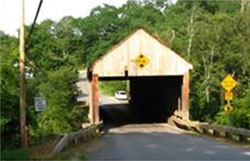
The Sayres Covered Bridge sustained damage from an overheight vehicle, police said. The vehicle broke and dislodged boards on the bridge, but does not appear to have caused structural damage, according to Thetford Police Chief Michael Evans. The damage was more severe on the south end of the bridge. Although someone picked up the broken boards and stacked them on a guardrail, no one has come forward to claim responsibility for the damage, Evans said. (Valley News, June 15, 2017)
WGN 45-14-13
Warren, Vermont
In late May 2017, Jan Lewandoski installed natural knee braces in the Lincoln Gap Bridge in Warren. The Lincoln Gap Bridge, built in 1880, is a queenpost truss with a bottom chord length of 59 ft. and a clear span of about 50 ft. The four knees installed in 2017 replaced 4"x4" diagonal braces which had sustained damage from oversized vehicles.
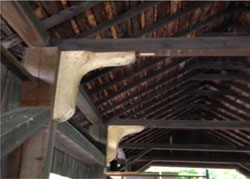
Although the natural knees are a departure from the original construction, they are within the tradition of covered bridge bracing with a few instances we are acquainted with in Vermont, New Hampshire, and Quebec.
Jan noted that the Fisher Bridge, the large 1908 double lattice truss railroad bridge in Wolcott, Vermont, has very large original natural knees at its portals. The Gratons installed a full bridge of knees at the nearby Big Eddy Bridge in Waitsfield, Vermont, in response to traffic damage and a low opening height. Jan has replaced four of them which were damaged by vehicles. Jan obtains the material for his knees from his neighbor's timberland. They are mostly white spruce, some red spruce, and some tamarack.
Jan added that although the knee braces may not have been original to the design of the bridge, they stay much further out of the roadway. Therefore, replacing straight 45 degree angle braces with natural knees helps reduce the potential for damage from oversized vehicles.
Hyde Park, Vermont
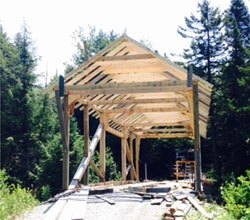
The Manosh Bridge is a 66 ft. queenpost truss bridge built on a private road in Hyde Park in 2016. The roadway is on preexisting steel beams, but the bridge is self-supporting, carrying the walls and roof. It is quite tall and large, with an opening 13 ft. 4 in. high and 17 ft. wide. The queenposts are 11 x 12 x 15 ft. and made of yellow birch, and the remaining material is mostly spruce and hemlock. It is braced by four pair of natural knees, shear-blocked and bolted to the tie beams and bolted and pinned to the posts. It sits on tamarak bed timbers. Both the joinery and the metalwork are typical of nearby 19th century queenpost truss bridges, such as those in Belvidere, Vermont.
From the Archives
Truss Bridge Built in 1870 by Harrison Chamberlin
Harrison "Tip" Chamberlin, born in Townshend in 1840, served in the Civil War, including the Battle of Gettysburg. When he returned, he became the owner of a lumber mill that was also used for cutting soapstone on West Hill. However, he was best known as a builder and a fine furniture maker. He built at least three houses in Townshend, plus the large 1894 Leland and Gray Seminary building.
His most important structures were the four covered bridges in Townshend - Scott Bridge, being the first, in 1870; then Depot Bridge in 1872; Holland Bridge in 1875; and Harmonyville Bridge in 1879. Scott Bridge was his largest bridge project, spanning a total of 277 feet. Construction of these bridges demonstrated remarkable ingenuity and was quite an admirable feat for a 30 year old carpenter and joiner.
Harrison Chamberlin died in 1924 at the age of 84, the last of the Civil War veterans in Townshend. He is remembered as "a man of thrift, energy, and creative faculty, whose days were filled with the pleasure of toil and the satisfaction of work well done."
Many years ago, Seth Allen of West Townshend was hired to re-shingle part of the Scott Bridge roof. Allen sometimes did things differently from anyone else, and he decided to do part of his work by moonlight. He used no stagings, and unless one happened to see him on the roof, there was no sign of activity.
Late one moonlit night, Leslie Lowe, a local fiddler who lived on West Hill, drove back from Townshend village behind his old horse Jerry. All was silent as he entered the darkness of the bridge. Suddenly, when he was about halfway across, hammering began above his head. What it was, Lowe could not imagine, and Jerry gave him no time to puzzle it out; the old horse took off at top speed as if the devil were after him. There ensued one of the wildest rides that Leslie Lowe ever took, and had not the hilly road finally slowed Jerry down, he would have been running until morning.
The Scott Bridge is actually three bridges, put in place by Harrison Chamberlin in 1870 after the flood of 1869. The "over-the-river" section is a 166-foot plank-lattice span. The 111-foot section, incorporating two kingpost spans supported by a pier, crosses a gully on the west bank, making the whole affair 277 feet long. The Kingpost trusses use iron rods rather than the old style timber posts. The Scott Bridge is considered to be the longest wooden bridge within the state.
The Town lattice truss is constructed of a matrix of planks pinned together with hardwood pins called treenails (pronounced "trunnels"). A lot of treenails are needed, however. 2,500 of them would be required for the 100-foot bridge. Please note that the "upper secondary chord" is missing on this bridge, likely because Ithiel Town's early patent drawing for the truss didn't feature one.
With the use of a nearby sawmill, the bridge was built in the meadow of Scott Farm. The trick was to have the bridge all built and ready so that the structure could be erected swiftly, before any sudden floodwaters might destroy the false works (cribbing) on which the new bridge would temporarily rest. Oxen were used to drag the lattice bridge into place, followed by the kingpost sections.
While there's no record of the board footage of the kingpost sections, some of which came from an earlier c. 1800 bridge, we're told that 51,514 board feet of lumber was used for the lattice bridge alone. The total cost of the bridge was about $5,000.
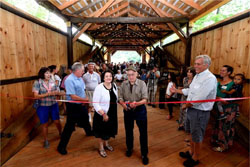
descendant of Harrison Chamberlain
Bob Watts Photo
In 2017, a rehabilitation project was completed by Renaud Brothers of Vernon, Vermont, at a cost of $2.35M - 81% from a federal grant, and the rest from the Vermont Division of Historic Preservation.
Scott Bridge is a national treasure, well worth preserving as an "extraordinary example of Vermont bridge engineering and architecture of the 19th century". (Hugh Henry, National Register Listing 1973)
Townshend, Vermont, October 14, 1955 - Our Society (the Connecticut River Valley Covered Bridge Society) was well represented, and a check for $25 was presented to Mr. Vrest Orton, Chairman of Historic Sites Commission. The President of the Boston Society, Mr. Leo Litwin, also attended the dedication and presented a check to Mr. Orton.
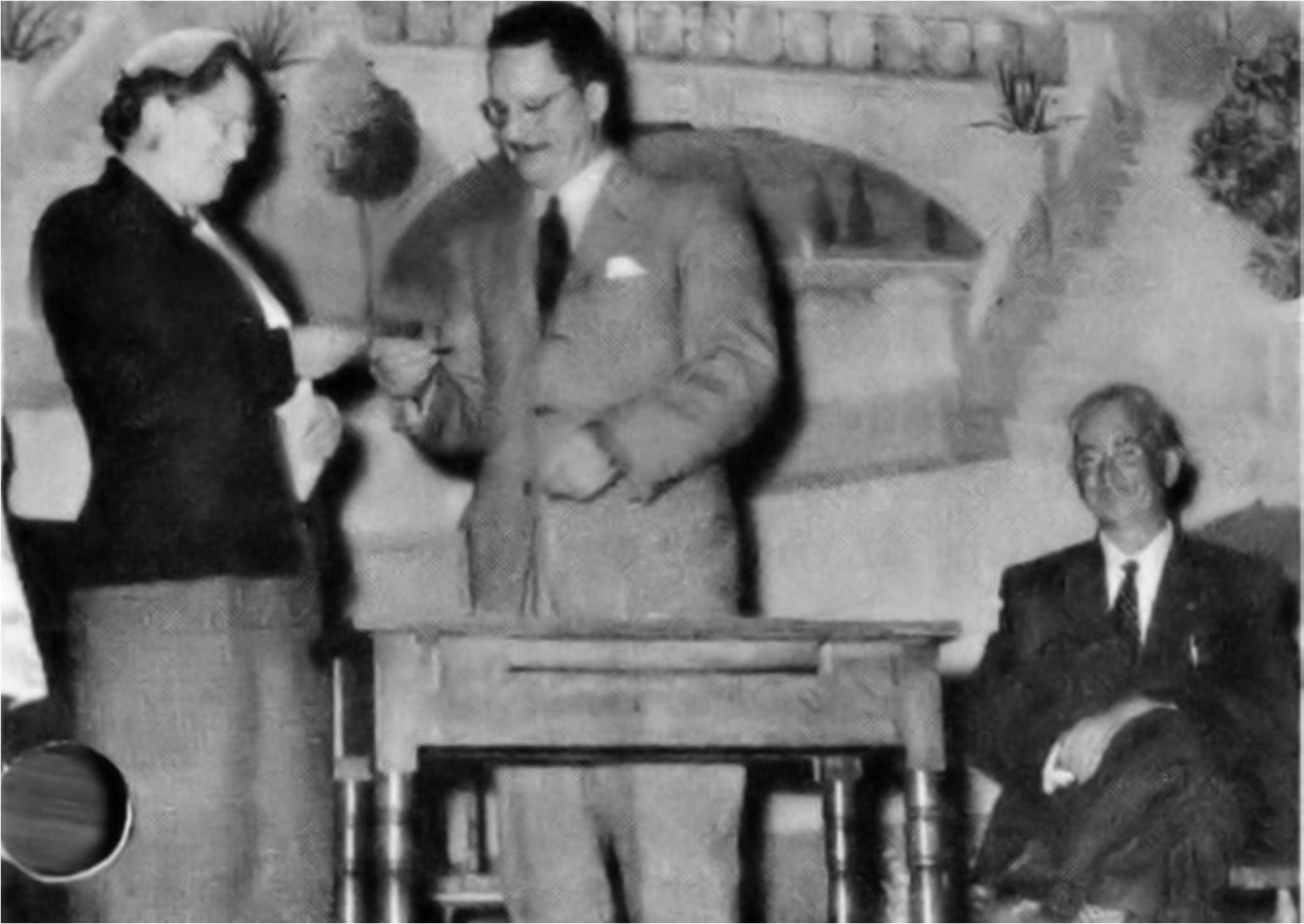
for the preservation of the Scott Bridge
Said Aubrey Stratton, Townshend Selectman: "Mr. Orton, Judge Gibson, Attorney General Stafford, and Friends: On behalf of the people of Townshend, I am happy to welcome the Vermont State Officials, distinguished guests, and friends of covered bridges here today.
"There probably won't be another ceremony of this kind here soon as we have no more covered bridges to give away. But, we hope we are doing this in a way that will be a step toward the preservation of Vermont's other old covered bridges.
"Scott Bridge got its name from the people who once lived on this farm. It was built in 1870 at a cost of about $5,000. The floor system for the long span was originally about one foot higher than that in the two short spans. So, it is plain to see that the builders, Mr. O. S. Howard and Mr. Harrison C. Chamberlain didn't see eye to eye. The curved arches were added some time later by my grandfather, Mr. Nelson Winslow.
"In 1950 money was raised for a repair job on Scott Bridge due to it having been heavily overloaded and bent out of shape. At this time, a good job was done on the bridge, which with reasonable use should have lasted another 25 years. The east end of the bridge was jacked up, new bed pieces put in, and a temporary pier put under the center of the bridge. The arches were jacked up on this pier and freed from the rest of the bridge, and the bent laminations replaced with new lumber. The latticework and the floor system were strengthened and broken cross members replaced. Later a new roof was added and new boards on the outside where needed. This repair job cost over $3,000.
"In 1953 the bridge was out of shape again due to being overloaded with heavy truck loads of logs, one right behind another on the long span, all being over the posted load limit for the bridge. We tried posting the bridge against trucks to be used for pleasure cars only, but that didn't work.
"At this time a new road was built on the west side of the river, to connect with Route 30 at the Holland Bridge. After money for the new road was raised by the town, with matched money from the State, the bridge was discontinued as a part of the highway system. Again, we were in trouble, as we didn't have enough money to construct a suitable highway, as the location required a lot of blasting, fill, and culverts. Again, the State came to our aid with 2 to 1 money raised by the town. Also, the State Forester allowed us to build a portion of the road through the State Park to do away with a bad spot, where the river held a mortgage on it.
"The new road to replace the bridge having been completed at a cost of nearly $20,000 and as the bridge was no longer a part of the highway system, we have sold Scott Bridge to the Vermont Historic Sites Commission for the sum of one dollar and other considerations.
"I am bound to present the bill of sale to Attorney General Stafford who represents Governor Johnson here today."
VCBS Lending Library:
Research Source
The Vermont Covered Bridge Society has assembled a lending library available through media mail to all society members in good standing.
Librarian Warren Tripp has created a detailed book list complete with a description and critique of each book. Copies of the index are available by mail, or you may contact Joe Nelson for an electronic copy at jcnelson@together.net or go to http://www.vermontbridges.com/whatis.vcbs.htm#item7. A borrower can contact Warren Tripp, who will send the book by Postal Service Media Mail. Books are returned the same way.
Send Warren the complete title of the book(s) you wish to borrow. He will respond with the mailing cost and mail the order when the fee is received. The borrower is then responsible to return the item(s) in a reasonable time, preferably no longer than two months. Contact Warren Tripp, P. O. Box 185, South Barre, VT 05670, fftwbt@yahoo.com, phone 802-584-3545.
For Sale
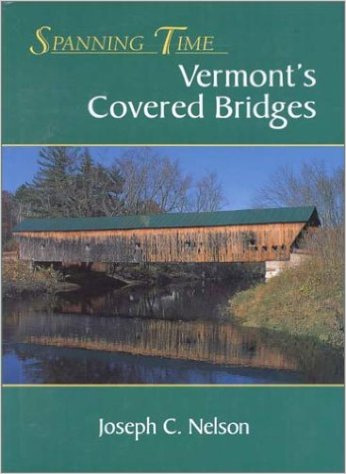
Spanning Time: Vermont's Covered Bridges features 102 color photographs of Vermont's covered bridges in fifteen chapters, each a guided tour. The tours are complete with maps, commentary on the uniqueness of each bridge, and historic highlights about the towns and villages in which the bridges stand.
An appendix provides: A Summary of Vermont's Covered Bridges, listing information on each; A Covered Bridge Glossary, describing the details of a covered bridge; A Bridge Truss section, explaining how trusses work with drawings of the trusses used in Vermont; The Bridge Builders, providing thumbnail biographies of people who designed and built the bridges; A Covered Bridge Reading List, for bridge and history buffs; A detailed Index. Spanning Time: Vermont's Covered Bridges: 7" x 10", 288 pages. Published by New England Press at P.O. Box 575, Shelburne, VT 05482. Spanning Time is available directly from the author for $39.00, free shipping.
Go to Spanning Time: Vermont's Covered Bridges Special Book Offer
Also see:
www.vermontbridges.com/bookreviews.htm.
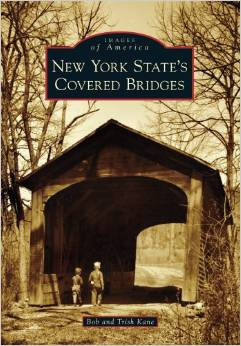
New York State's Covered Bridges - When one typically thinks of covered bridges, New York is not the first state to come to mind, but New York once had over 300 covered bridges. Floods, fires and progress have claimed all but 32. Readers will enjoy seeing NY's current bridges, including the oldest existing covered bridge in the U.S., the Hyde Hall Covered Bridge, located in Glimmerglass State Park, and the world's longest singlespan covered bridge in the world, the Blenheim Covered Bridge, washed away by Tropical Storm Irene in 2011. This book also highlights the Theodore Burr Covered Bridge Resource Center in Oxford, NY, the first ever center of its kind specifically designed for covered bridge researchers.
To obtain a copy of the tour, contact:
Visions of Vermont Art Gallery Jeffersonville, Vermont
https://www.visionsofvermont.com/
802.644.8183
A special sale for the benefit of the Vermont Covered Bridge Society featuring the works of Eric Tobin. All proceeds of the unframed prints go to the VCBS. Sale of the framed prints will be shared 50/50. They are all Giclèe on acid free paper. The glass is non-glare artist's glass.
- Print Size
- 10 x 12
- 16 x 20
- 16 x 20
- 20 x 24
- Format
- Unframed
- Unframed
- Matted and Framed
- Matted and Framed
- Price
- $125
- $175
- $550
- $850
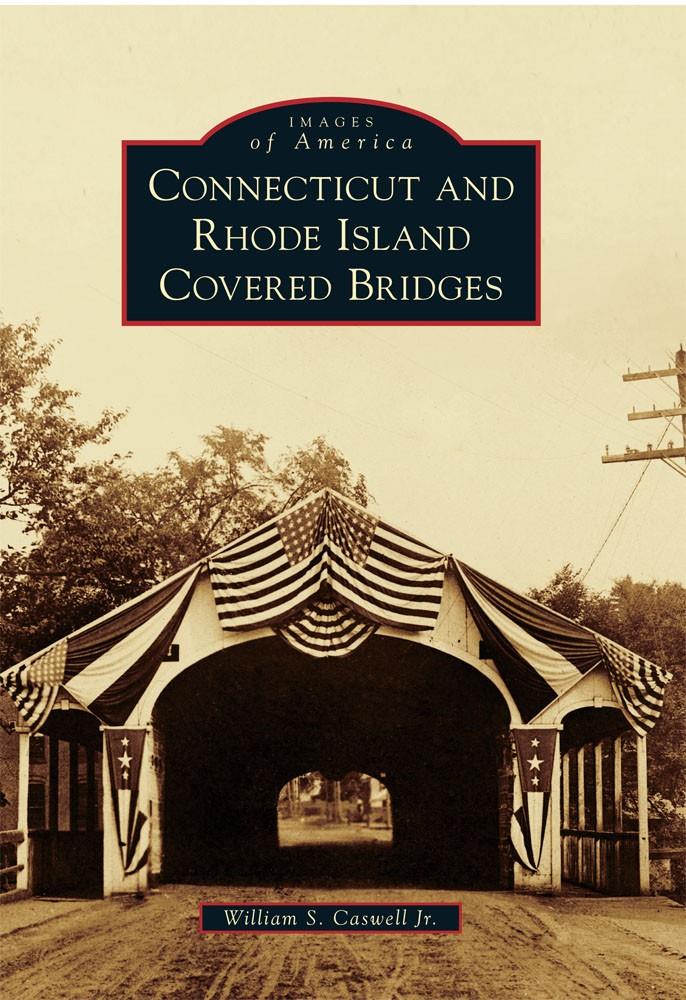
Connecticut and Rhode Island Covered Bridges-Price reduced
During their heyday in the mid to late 1800's, more than 150 covered bridges dotted the landscape of Connecticut and Rhode Island. Since that time floods, fires, and progress have claimed all but two of the historic structures. With over 200 images, this book provides insight into the covered bridge history of an area that has not been well documented in the past.
To order your signed copy, send $20.00 to:
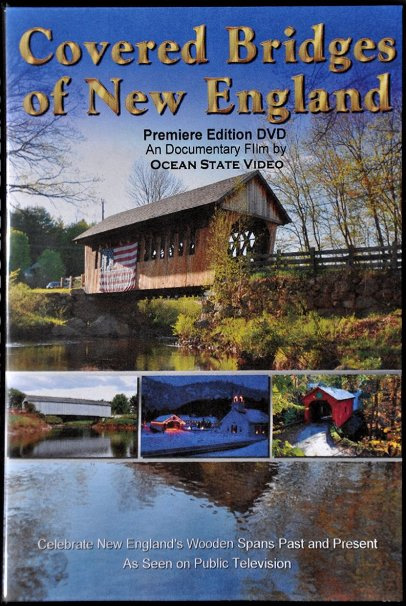
Covered Bridges of New England - DVD. Produced by Ocean State Video of Rhode Island for Public Television. On Sale: $20.00. Profits will go to the Vermont covered Bridge Society's Save-A-Bridge Program. For your copy send $20.00 plus $2.50 shipping to Joe Nelson, P.O. Box 267, Jericho, VT 05465-0267.
- President
- Bill Carroll
- 5 Hutchinson Lane
- Lenox, MA 01240
- wcarroll@crocker.com
- VP/Communications
- Joe Nelson
- PO Box 267
- Jericho, VT 05465
- jcarlnelson@yahoo.com
- Secretary
- Irene Barna
- 7 Forbes Circle
- Middlebury, VT 05753
- ibarna@middlebury.edu
- Membership
- Dan Monger
- teelmonger@gmavt.net
